

Here's What Really Motivates You. I learned a lot from Daniel Pink’s Drive: The Surprising Truth About What Motivates Us.
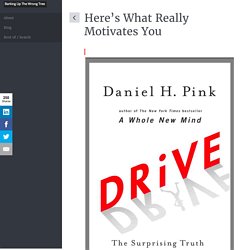
For any job that requires thought, creativity or problem-solving, Pink doesn’t recommend a focus on concrete rewards and punishments. He feels there are three elements we must provide to workers in this category: (1) Autonomy—”the desire to direct our own lives;”(2) Mastery—”the urge to make progress and get better at something that matters; and”(3) Purpose—”the yearning to do what we do in the service of something larger than ourselves.” On the other hand, if “the assignment neither inspires deep passion nor requires deep thinking. Carrots, in this case, won’t hurt and might help. The Point Of School Isn't To Get Good At School: Transfer As The Goal Of Education.
The Point Of School Isn’t To Get Good At School by Grant Wiggins On May 26, 2015, Grant Wiggins passed away.
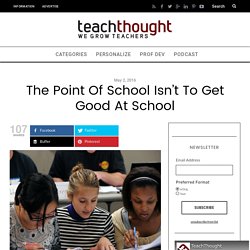
Grant was tremendously influential on TeachThought’s approach to education, and we were lucky enough for him to contribute his content to our site. Occasionally, we are going to go back and re-share his most memorable posts. This post on ‘transfer’ is one of those posts. Arguably transfer is the aim of any education. “Why are we doing this Miss?” When this question arises, I have a habit of immediately replying “because it is absolutely essential in the oil industry.”

Then I watch their face fall. I am convinced that rarely are learners actually asking where the topic of the ideas or the procedures are going to be useful, even when it comes out that way. Why Parents Don't Understand How To Help - Why Parents Don’t Understand How To Help by Terry Heick Jargon is a necessary evil.
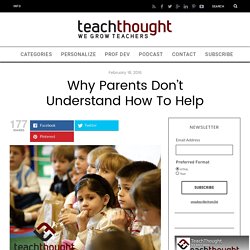
Simply put, jargon helps us be more specific. The Hard Part They never tell you in teacher school, and it’s rarely discussed elsewhere.

It is never, ever portrayed in movies and tv shows about teaching. Teachers rarely bring it up around non-teachers for fear it will make us look weak or inadequate. Valerie Strauss in the Washington Post once put together a series of quotes to answer the question “How hard is teaching?” And asked for more in the comments section. My rant didn’t entirely fit there, so I’m putting it here, because it is on the list of Top Ten Things They Never Tell You in Teacher School. The hard part of teaching is coming to grips with this: There is never enough. There is never enough time.
As a teacher, you can see what a perfect job in your classroom would look like. You know all this, but you can also do the math. 110 papers about the view of death in American Romantic writing times 15 minutes to respond with thoughtful written comments equals — wait! Robert Duke. Simplifying Radicals: Never Give Up, Never Never Give Up, Never Never Never Give Up. Deeper Learning: Performance Assessment and Authentic Audience. In a conversation with a veteran educator -- a man with years of experience teaching English and acting as a headmaster -- I was confronted with a prejudice so ingrained in my teaching that I was almost embarrassed to admit it.
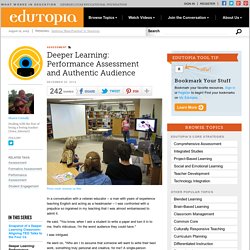
He said, "You know, when I ask a student to write a paper and turn it in to me, that's ridiculous; I'm the worst audience they could have. " I was intrigued. He went on, "Who am I to assume that someone will want to write their best work, something truly personal and creative, for me? A single-person audience is a pretty lame audience, let alone the fact that I'm a middle-aged white guy. " That hit me like a rolled-up newspaper. I Lie About My Teaching. I liked Devon.
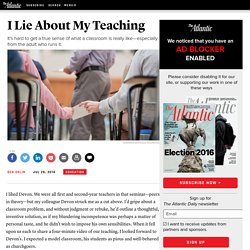
We were all first and second-year teachers in that seminar—peers, in theory—but my colleague Devon struck me as a cut above. I’d gripe about a classroom problem, and without judgment or rebuke, he’d outline a thoughtful, inventive solution, as if my blundering incompetence was perhaps a matter of personal taste, and he didn’t wish to impose his own sensibilities. When it fell upon us each to share a four-minute video of our teaching, I looked forward to Devon’s. I expected a model classroom, his students as pious and well-behaved as churchgoers. Instead, the first half of Devon’s four-minute clip showed him fiddling with an overhead projector; in the second half, he was trotting blandly through homework corrections. Building A Better Taco Cart. And by “taco cart” I mean “digital math curriculum.”
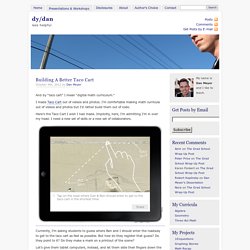
I made Taco Cart out of videos and photos. I’m comfortable making math curricula out of videos and photos but I’d rather build them out of code. Justin Reich » Preparing Students For Learning, Not Lectures, In College. “But in college, a lot of the learning happens in lecture halls, with professors talking behind a lectern and students taking notes.

We need to prepare our students for that reality.” As I’ve travelled to various school communities talking and listening about technology in classrooms, this comes up as one of the most common “Yeah, buts.” The argument goes like this: middle and high school teachers have to lecture and make students take notes because that is what college is like. I’ve never found the argument particular persuasive. I suspect that you could probably teach all of the skills for note-taking and sustained attention endurance in, at most, about a month, and if students had one class a year in secondary school that followed this model, that would probably be plenty of practice.
All that said, college instruction–especially at elite institutions–is being closely re-examined. Research on classroom teaching in higher education is driving these changes as well. Techniques for Unleashing Student Work from Learning Management Systems. Ari Moore/Flickr By Justin Reich Helping students become networked learners begins by thinking carefully about where we conduct our online learning.
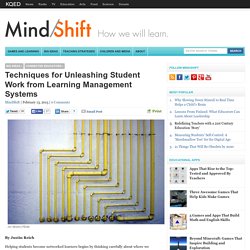
Most online learning in higher education and in K-12 takes place in Learning Management Systems (LMS) such as Canvas, Moodle or Blackboard. In higher education in particular, these LMS are designed to scale up the distribution of course materials — by default they are configured to distribute syllabi, course readings and assignments. Student contributions are usually limited to discussion forums and assignment submissions. Video Games & Making Math More Like Things Students Like. The 2014 NOLA Sessions. No, I Don’t Personalize Learning. Personalized learning. Differentiated learning. Learning Logs to inspire and guide student growth. August 17, 2014 by Nick Mitchell A problem I’ve been kicking around for a while is how to give my students clearer feedback on their learning progress. In a standards-based system this can be a challenge, because feedback is more detailed than a single percentage grade; a single assignment often covers more than one learning goal and therefore is given multiple grades.
This detail can be very useful to the student for guiding their learning, but only if they are able to take it all in and manage the feedback in a positive way. Unfortunately, most grade books out there haven’t mastered standards-based grading, making it difficult for both teachers to enter grades and students to access and understand them.
Scientists on science education. Why we’re not wired to think scientifically (and what can be done about it) Two years ago I was having dinner with a good friend, Rik Ganju. Rik is one of the smartest people I know. And one of the most talented, too—a brilliant engineer, a savant-like jazz musician, a comedic writer, and he makes the best coffee I’ve ever had (I may even share the recipe). The Spirit of SBG. Teachers: It’s OneNote to the rescue! - OneNote. As a teacher, I'm always looking for efficient ways to store information and to recapture it for immediate use in the classroom. As keen as I am on databases (I'm a Microsoft Certified Database Administrator), a dedicated database of information would be overkill for a classroom presentation.
By the time I'd open Microsoft Office Access and run a query, my poor students would be snoozing. For teachers, information repositories are only as good as how easy they are to access. Enter Microsoft Office OneNote 2007. Boxbayvceaakpil.jpg (600×450)
A Visualization of Current Concerns — Knuffke.com. CUE 2014: Dan Meyer - Capturing, Sharing, and Resolving Perplexity Are We Taking Our Students’ Work Seriously Enough? ” credit=”Erin Scott In the course of studying different aspects of children’s environments, Dr. Roger Hart noticed that “a lot of supposedly participatory projects had a distinct air of tokenism. Children were being put on display, so to speak, as though they were actively participating, but they were not taken seriously.”
To get people talking about this issue, Hart, who serves as director of the Children’s Environments Research Group at the City University of New York and helps lead the Article 15 Project, a children’s rights organization, adapted a colleague’s ladder metaphor. He labeled the rungs: 1. 2. 3. 4. 5. 6. 7.